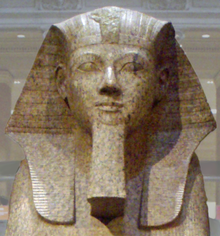Egypt is one of the most famous early river valley civilizations of all time. Its history has fascinated people all over the world, and there still enigmas that historians are trying to decipher. We can not talk about Egypt without talking about the pharaohs. They were the kings that ruled Egypt, also considered as gods. My report is focus on the fifth pharaoh of the 18th dynasty, Hatshepsut.
This is a portrait of the queen Hatshepsut, ruler of the 18thdynasty (New Kingdom). This 76 3/4in. free-standing sculpture shows a feminine style of the pharaoh even though in most of her statues she dresses like a man. Emphasizing on the steady position of Hatshepsut the artist subordinate the writing around her legs, which says “Daughter of Re” and “Lady of the Two Lands”. The sculpture shows a frontal position of Hatshepsut with her hands on her lags seated on a “chair”. This closed form artwork carved from limestone rock is well damaged, not because limestone is a sedimentary rock, but because when she died and TuthmosisIII reassumed power “her name and image were widely erased as being too gender-aberrant to remember”. The sculpture is an asymmetrical well balanced with both a combination of geometric and organic shapes. The unique medium the sculptor used to carve this steady position of Hatshepsut give the artwork unity.
I really like this statue of Hatshepsut. The reason why I choose it was the history of her background. It is amazing how she brought wealth to Egypt. And what makes the story
more exciting is the fact that she was a female ruler. This sculpture makes you contemplate about how she would be, and why she is posing like that? I get the feeling of respect by her serious face and also of sadness, because she looks unhappy. It is weird that you do not see her breast.
Second the article about Hatshepsut on the web page Wikipedia, “Hatshepsut was the fifth pharaoh of the eighteenth dynasty of Ancient Egypt”. She ruled from 1479 BC to 1458 BC. Egypt ruled by woman was an unfamiliar fact, but not unprecedented. There were already lots of female rulers before Hatshepsut became a pharaoh. But comparing her reign with the other females’ pharaohs, her reign was much longer and prosperous than the others. She is recognized to be the pharaoh who inaugurated a peaceful era, and she also succeeded in warfare early in her reign. She brought great wealth to Egypt by re-establishing lost trading relationships. The benefits from her policies and administration enable her to initiate building projects which would raise the caliber of Ancient Egyptian architecture. Later pharaohs attempted to have their names on Hatshepsut’s accomplishments.
The sculptor of this piece of art is unknown. The sculptor wanted us to evoke the image of a big leader, and of a wonderful woman. The sculptor also depicted the words “Daughter of Re” and “Lady of the Two Lands” so we can understand better the artwork. Though the sculptor did this artwork for the “king” on her commandments, the sculptor might have his own subjectivity on it.
Here is a sculpture of Hatshepsut on a "male" style.
Citations:
"Hatshepsut." Wikipedia, the Free Encyclopedia. Web. 10 Nov. 2011. <http://en.wikipedia.org/wiki/Hatshepsut>.
"Hatshepsut [Egyptian; From Deir el-Bahri, western Thebes] (29.3.2)". In Heilbrunn Timeline of Art History. New York: The Metropolitan Museum of Art, 2000–. http://www.metmuseum.org/toah/works-of-art/29.3.2 (October 2006)
Lewis, Jon E. "Part Three: Empire." The Mammoth Book of Eyewitness Ancient Egypt. New York: Carroll & Graf, 2003. 115-16. Print.


No comments:
Post a Comment